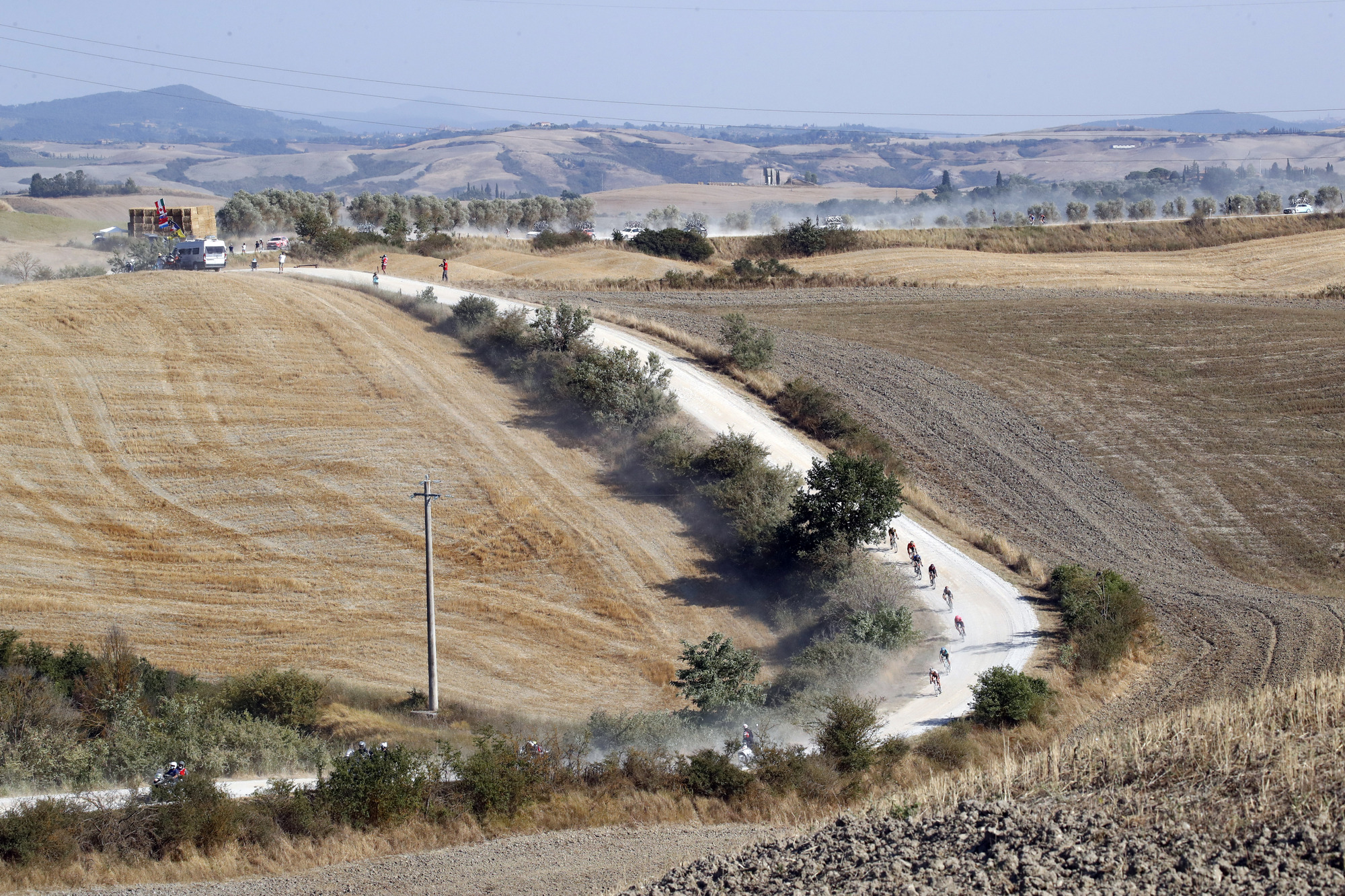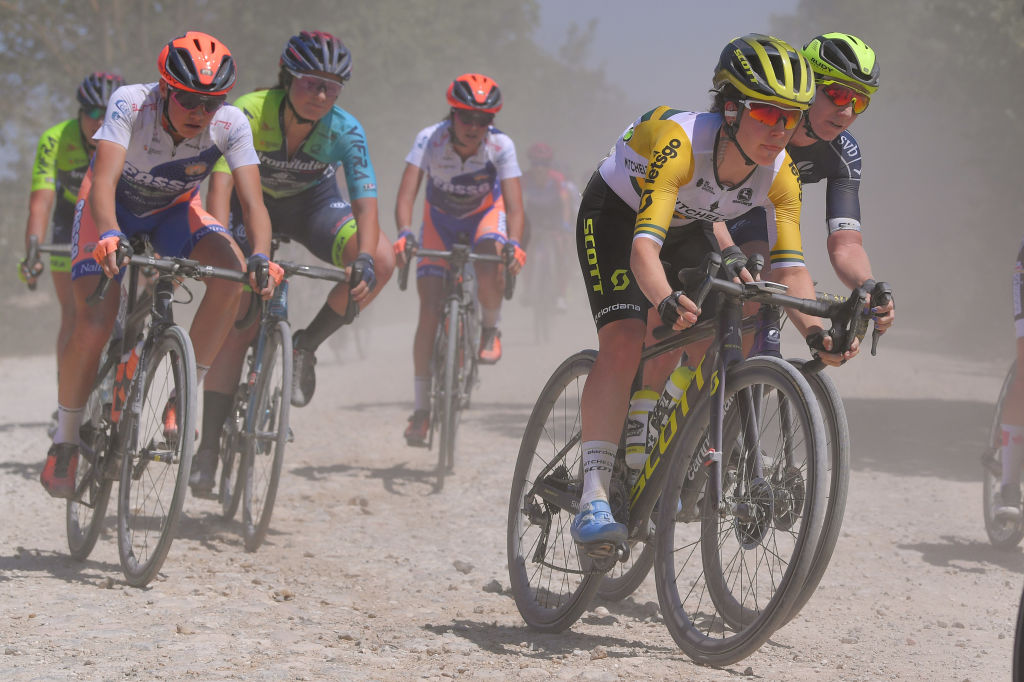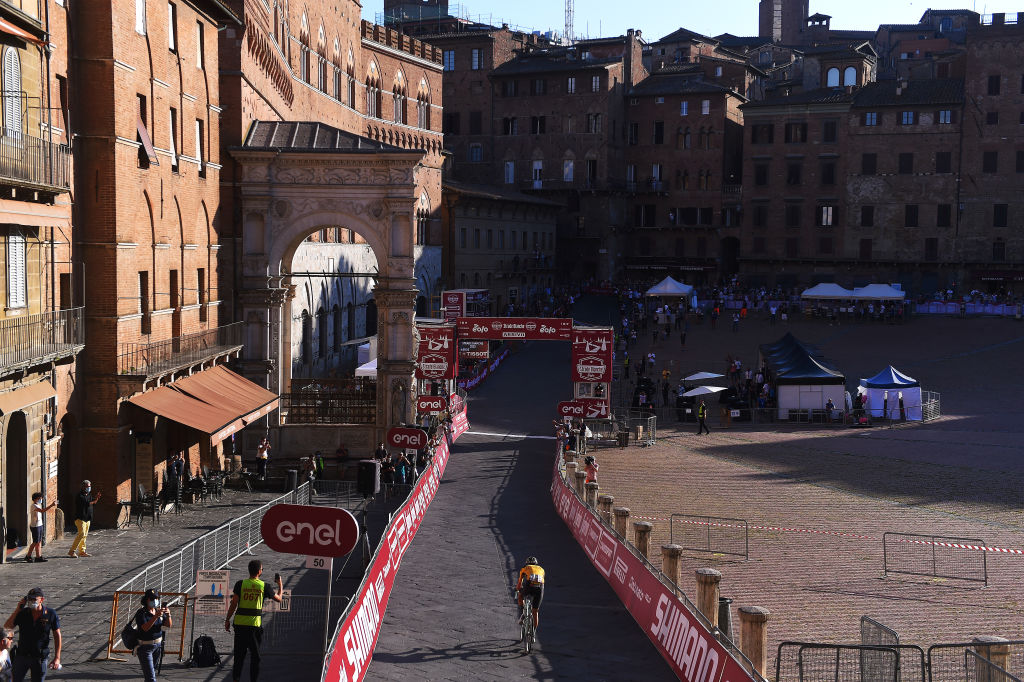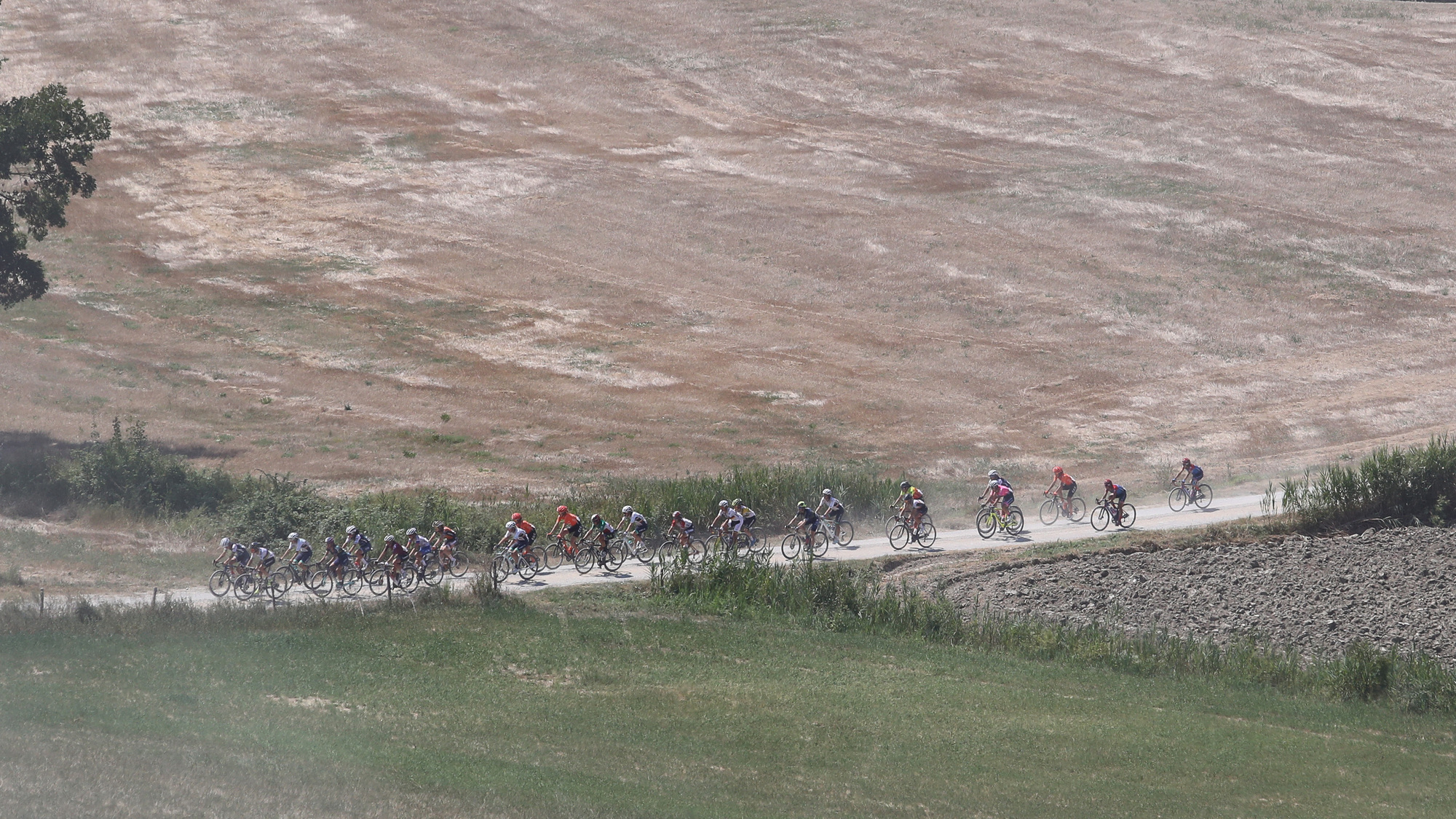Strade Bianche: A modern classic
Procycling magazine finds out what makes Strade Bianche so special

Strade Bianche has become one of the most important events in the world. Procycling looks at what makes the race so special.
This article was taken from Procycling magazine issue 278, February 2021.
Subscribe to Procycling magazine here.
The Piazza del Campo is no stranger to sporting events. It hosts the Palio di Siena, a horse race with medieval origins. Ten horses and their riders thunder around the tight square for three laps, in a terrifying spectacle that often lasts less than two minutes, and riderless horses are a common sight. The ‘modern’ race dates back to 1633, emerging from earlier races across the whole city, and various fighting events which took place in the square in the preceding centuries.
Cycling fans know the Piazza from the finish of Strade Bianche, which comes after riders have ascended the vertiginous Via Santa Caterina. The race, like the Palio, also emerged out of an earlier event: L'Eroica Strade Bianche, the heroic race of the white roads, an amateur event that began in 1997 and spawned a professional offshoot in 2007. This modern classic allows heroes of the peloton to emerge: riders who can conquer the white roads, the eponymous gravel sectors.
Beethoven’s Eroica Symphony is often credited as the first Romantic work. The Tuscan Eroica is certainly romantic as well as heroic, taking its protagonists across the most beautiful parts of Chianti, the dramatic landscape providing a beautiful backdrop for the action and evoking past eras of cycling.
The founder of the original amateur event, Giancarlo Brocci, is clear on why Strade Bianche is unique in the modern cycling calendar: “It is heroic, because it has rediscovered those magnificent roads without asphalt where the special qualities of the rider still make the difference, such as skill, courage, dexterity, deciding at a glance, the ability to suffer.”
Get The Leadout Newsletter
The latest race content, interviews, features, reviews and expert buying guides, direct to your inbox!
Brocci continues: “Obviously, the race setting is also unique: the magnificent landscapes surrounding Siena, where these roads have been preserved. The dust or the mud, on rainy days, revive the legend of the golden age of cycling, making for fantastic photos that transmit heroism and quickly travel around the world, striking those who see them and making the feat impressive for each of the protagonists and for the teams they represent.
“If we are talking about beauty, I believe that the white roads of Siena and L'Eroica are unique and unrepeatable.”
The final part of the race up into Siena is just as attractive as the landscapes out in the countryside, as the leaders thread their way through the medieval city’s narrow, steep roads, into the arena of the Piazza. The romantic nature of the race is clear.

Throwback to the past
Brocci founded L’Eroica to highlight the plight of Siena’s white roads, which were being tarmacked over at an alarming rate, much like the cobbled roads of Northern France that have been preserved thanks to their association with Paris-Roubaix. However, it became apparent that the format was popular and had more to give than being just a granfondo. Cycling journalist Richard Hallett rode in the event the first year that Brooks, the saddle makers, sponsored it in 2004. Returning over the next four years, he saw its growth.
“The resulting press coverage led to something of a craze for such rides. Within a few years numbers rocketed to the point where riders had to be restricted to vintage machines,” he tells Procycling. In the amateur event, riders use pre-1987 bikes, with steel frames and toe clips, dressed in old-school cycling gear.
Hallett believes this wildly popular granfondo is partly responsible for the growth of gravel riding, while its popularity led to the creation of the most successful ‘new’ professional race, with the pro men first racing over the white roads in 2007, and their female counterparts in 2015.
Bora-Hansgrohe’s Maciej Bodnar took part in that first race 14 years ago as a neo-pro, and remembers it well: “I met a lot of big riders. When you are a young rider, you’ve only seen these guys on TV before, and then to race with them was cool. It was more than 30 degrees, you couldn’t see anything. It was a really tough race. After the feed zone, I was alone, many riders had retired already, and someone told me I was the last guy on the road, so I retired.”
The white roads are part of the identity of Tuscany, found in tourism brochures and classic films about the area. To create a new history for the iconic roads was a masterstroke, with riders invited to make legends of themselves on the rough surface.
Not that the gravel stretches are as difficult to ride on as they sometimes look. Hallett explains: “The white roads are surprisingly fast. They are done basically the way most roads used to be done until the 1930s, and are long lasting and surprisingly fast. It’s not like riding cobbles like at Flanders or Roubaix, where it’s hard to get speed up and it’s desperately uncomfortable. That is not the case on the gravel roads. It’s a very pleasant situation, as long as you’re not on the bits with corrugations. But on the flat stuff it’s nice.”
The strade bianche are what make the event a “super special” race, according to record three-time winner Fabian Cancellara. “It’s not gravel, it’s not the cobbles, it’s not forest roads, these are historic roads. If you watch old films set in Tuscany, you see houses on top of the hills, these white roads…” he says.
“The sectors are hard, but they are not quite as bad as Flanders, but there are flat parts, up, down and corners, too.”
Kasia Niewiadoma, who has recorded four podium placings at the race, and therefore is the most consistent female rider, says that the white roads are deceptively steep: “You can’t see how steep the hills are on TV. We are swaying our bodies side to side just to keep going. I feel by this point, because all the steep points are at the end of the race, that you’re so tired that when I get out of the saddle I go slower, so I always try to stay in my saddle and try not to be dropped.”

A race for everybody
Strade Bianche is fascinating because it has had such a short life, and yet is already one of the biggest races on the calendar each year. The monuments are monumental because they have all been going for over 100 years. The iconic stage races, like Paris-Nice or the Tour de Suisse, date back to the inter-war period, and have the history to give them that status, too. The Tour de France, the grandest race of all, owes some of its reputation to being the oldest grand tour.
Cancellara makes this point: “Some races have 80, 70 years on their shoulders. This race doesn’t have as many, but the race is already on such a high prestige that the achievement is special.”
What gives it that prestige? Brocci reckons it’s the fact that the race takes cycling back to its earlier days, where titans of the road duelled: “The message from the worldwide appreciation of L’Eroica and the Strade Bianche, its pro version, is that people want to regain their great passion for cycling.”
It is the breadth of riders who can perform at the race that makes it special for Cancellara. He explains: “There has been a lot of interest from all different kinds of riders: from GC guys, climbers, one-day classics riders... That’s why I think it’s special, and I also think it has become interesting for people for gran fondos, and interesting for the bike industry as well. The white roads aren’t just gravel, it depends on the weather. It’s difficult to say who is best for the race. It’s a race that is tough, it’s a race that starts early. You have to be powerful, you have to have gas in the tank, and you need to have quite good skills as well on the gravel.”
Niewiadoma explains that its success lies in its brutality: “Strade is one of the first races, and you never know what to expect after winter time, who’s in good shape. I think everyone just fell in love with it. It’s so brutal, it’s so hard, and the night before you blame yourself for being on the team for that race because you know what’s going to happen.
“A couple of years ago we had this brutal edition where there was a lot of rain and it was really cold, so everyone is hating it before and during the race. After it you have this sense of accomplishment that is so hard to describe, you’re so proud of yourself for doing it, for pushing yourself through the gravel sections where you just want to give up.”

A tough race
The race is undeniably very hard. Bodnar, who has raced Strade 10 times, says that he has actually asked his team to not put the race in his schedule any more, unless it’s imperative. “Two years ago I did my first race in the rain. I did it 10 times, so I said to the team, ‘I don't need to do this any more.’ Two years ago I crashed with Daniel Oss on the front, and one of the stones cut the side of my head. I said to the team that the race was really hard, if I needed to do it I would, but they should take other people. It’s a nice race to watch, but I don’t need to be there any more.”
In its now traditional March slot in the season, the race takes place in classic spring weather, with rain often on the forecast, though the sun can also shine, and one year it was hit by gale force winds. However, in 2020, with the race moved to August due to the pandemic and lockdown, riders were forced to swelter in heat of over 35 degrees.
Mikayla Harvey, the rider from New Zealand, said it was her toughest day on a bike: “It was so hot. The last hour of that race everybody was overheated. I started to feel cold because I was so hot. Just getting to the finish line was such a battle. To finish was a feat in itself. Some girls had to walk up some of the gravel climbs because it was that brutal.”
In results reminiscent of another time, only 45 women and 42 men finished inside the time limit. Rob Stannard said that he felt like he couldn’t sweat, “because there was so much dust all over me”. Greg van Avermaet, Olympic champion, said that he vomited after the finish line, his effort was so intense.
Perhaps that’s what makes this race so popular with fans, and why riders so want to win it, because it is tough in a different way to other races. Despite saying how hard it is, Niewiadoma says: “I really love the race. I remember going there with my old team, Rabobank. We did a recon just for fun at the end of the season. We raced on some of the white roads on really old bikes. After that, they said that they were going to start a women’s edition, and I knew that it was going to be the goal of my entire career to win that race.”
Brocci argued that his event, and the professional race which he spawned, are evidence that there is a desire for ‘old’ cycling to return: “There is too much technology, too many experts and teams of scientists following cyclists, in a sport that, fundamentally, has always remained true to itself, that would like to go back to believing in and getting excited about the feats of champions that last a generation and are able to ride seriously and continuously from March to October.” The race’s popularity is based on nostalgia, even though it’s only 15 years old.
Strade Bianche is fascinating because of the range of riders who can do well at the race, as Cancellara says: “The recent winners have been various types, but there’s always a prestige podium. In Flanders or Roubaix it’s not the same as in Liège, but at Strade you have everything.”
Other races have specific riders that target them; you would not have seen Cancellara, he of three Roubaix and Flanders victories, targeting an Ardennes classic or Lombardy. A rider like Alejandro Valverde or Romain Bardet winning on the cobblestones is implausible. Yet at Strade, all of these riders come together.
Looking at the list of podiums, it’s clear what Cancellara meant by “prestige”. The best all-rounders are always at the top: Wout van Aert, Julian Alaphilippe, and Michał Kwiatkowski have all won in recent years, and are all monument winners too. Bardet, who has finished second in the Tour, finished second in 2019, and Valverde, a Vuelta winner, came third in 2014 and 2015.
It almost feels like a version of the World Championships, such are the varied skill sets of those who succeed at the race. This is what makes the race stand out, makes it unique in an age of increased specialisation.
For Brocci, to be good on the white roads, you need to be more than a top athlete: “What makes a cyclist perfect for this type of race is first and foremost a passion for the sport. Because all those who have ridden the Strade Bianche, as it is now called, say that they enjoy it and that it is a unique experience. It is clear that they need the old ability to guide the bike, they need courage and a taste for conquest; they need to love their sport deeply, as a sport, not just as a job.”
It is always, as Cancellara puts it, a “drama race”, just like the Palio that it shares the Piazza del Campo with. Who needs history when you have drama?
Adam Becket is Procycling magazine's staff writer.
Procycling magazine: the best writing and photography from inside the world’s toughest sport. Pick up your copy in all good newsagents and supermarkets now, or pick up a Procycling subscription.
Adam Becket is the staff writer for Procycling magazine. Prior to covering the sport of cycling, he wrote about ecclesiastical matters for the Church Times and politics for Business Insider. He has degrees in history and journalism. A keen cyclist himself, Adam’s favourite race is the Tour of Flanders or Strade Bianche, and he can't wait to go to the Piazza del Campo for the end of the race one day.